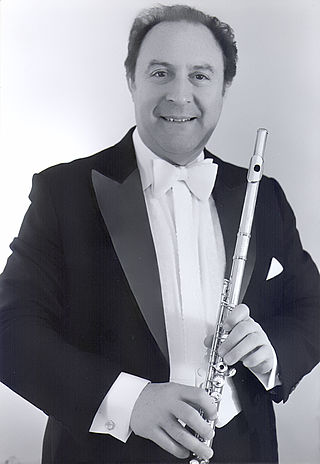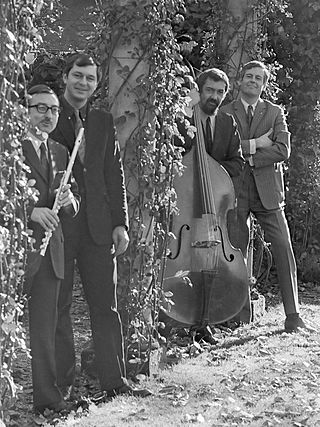Related Research Articles

Jean-Pierre Louis Rampal was a French flautist. Rampal popularised the flute in the post–World War II years, recovering flute compositions from the Baroque era, and spurring contemporary composers, such as Francis Poulenc, to create new works that have become modern standards in the flautist's repertoire.

Marcel Moyse was a French flautist. Moyse studied at the Paris Conservatory and was a student of Philippe Gaubert, Adolphe Hennebains, and Paul Taffanel; all of whom were flute virtuosos in their time. Moyse played principal flute in various Paris orchestras and appeared widely as a soloist and made many recordings. His trademark tone was clear, flexible, penetrating, and controlled by a fast vibrato. This was a characteristic of the 'French style' of flute playing that was to influence the modern standard for flutists worldwide.
William Ingham Brooke Bennett was a British flautist and teacher. He played in many English orchestras and chamber music ensembles, and as a soloist. He made more than 100 recordings, including chamber music with partners including George Malcolm, Osian Ellis, and Yehudi Menuhin. He premiered flute concertos written for him, by William Mathias, Diana Burrell and Raimundo Pineda. Bennett taught at the Hochschule für Musik Freiburg in Germany and the Royal Academy of Music, and held master classes worldwide.

The Conservatoire de Paris, also known as the Paris Conservatory, is a college of music and dance founded in 1795. Officially known as the Conservatoire National Supérieur de Musique et de Danse de Paris (CNSMDP), it is situated in the avenue Jean Jaurès in the 19th arrondissement of Paris, France. The Conservatoire offers instruction in music and dance, drawing on the traditions of the 'French School'.

Louis Fleury was a French flautist, a student and colleague of Paul Taffanel, a writer who advocated for the revival of Baroque music, and a musician who promoted contemporary composers by commissioning and performing their work.
The Western concert flute is a family of transverse (side-blown) woodwind instruments made of metal or wood. It is the most common variant of the flute. A musician who plays the flute is called a “flautist” in British English, and a “flutist” in American English.

Trevor Wye is a professional flautist, flute instructor, and author of several books about technical aspects of flute playing. He founded the International Summer School for flute.

Henri Benjamin Rabaud was a French conductor, composer and pedagogue, who held important posts in the French musical establishment and upheld mainly conservative trends in French music in the first half of the twentieth century.

Philippe Gaubert was a French musician who was a distinguished performer on the flute, a respected conductor and a composer, primarily for the flute.
Geoffrey Winzer Gilbert was an English flautist, who was a leading influence on British flute-playing, introducing a more flexible style, based on French techniques, with metal instruments replacing the traditional wood. He was a prominent member of five British symphony orchestras between 1930 and 1961, and in 1948 he founded a chamber ensemble of leading wind players.
Joseph Rampal was a distinguished flutist in his own right, albeit better known as the father of the internationally renowned soloist Jean-Pierre Rampal.

Claude-Paul Taffanel was a French flautist, conductor and instructor, regarded as the founder of the French Flute School that dominated much of flute composition and performance during the mid-20th century.
Philibert RebilléditPhilbert was a French flautist.
Robert Langevin is a Canadian flautist. He has been principal flautist of the New York Philharmonic since 2000 and is a former principal flautist of the Pittsburgh Symphony Orchestra. He was associate principal flautist with the Montreal Symphony Orchestra for 13 years and can be heard on more than 30 recordings with that orchestra. He is a former faculty member of Duquesne University and the Université de Montréal. He currently serves on the faculties of the Juilliard School and the Manhattan School of Music.
The Flute Concertino in D major, Op. 107, is a concertino composed in 1902 by French composer Cécile Chaminade. It was originally written for flute and piano, but Chaminade later arranged it for flute and orchestra.

Adolphe Hennebains was a French classical flautist and music teacher.
Léopold Lafleurance was a French flutist and professor.
Georges Laurent was a 20th-century French flautist.

Raymond Guiot is a French flautist, pianist and composer. He has also trained many flutists throughout the world.

The Fantaisie for flute and piano, Op. 79, is a chamber music composition written by Gabriel Fauré in 1898.
References
- ↑ Dorgeuille, pg. 16
- Debost, Michel, The Simple Flute: From A to Z. Oxford University Press, 2002.
- Dorgeuillie, Claude, and Edward Blakeman, The French Flute School: 1860-1950. London: Bingham, 1986.
- Fleury, Louis and Frederick H. Martens, "The Flute and Flutists in the French Art of the Seventeenth and Eighteenth Centuries," The Music Quarterly, vol. 9, no. 4.
- Myers, Arnold, "Marcel Moyse" The Galpin Society Journal, vol. 49.
- Powell, Ardal, The Flute. New Haven: Yale University Press, 2002.
- Gearheart, Sarah, Exploring the French Flute School in North America: An Examination of the Pedagogical Materials of Georges Barèrre, Marcel Moyse, and Renè De Roy, May 2001.